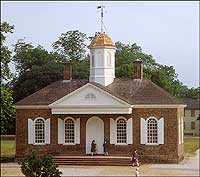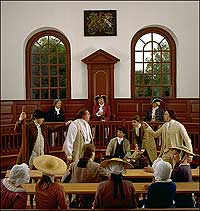Page content
Courthouse

- Benjamin Waller read Declaration of Independence from steps of courthouse
- Treaty of Paris ending Revolutionary War announced here
- Absence of columns startling
- Double doors opened directly onto courtroom
- Unknown architect designed brick building on a geometric scheme
- Courthouse central to town and center of community
- Colonial Williamsburg secured rights to building in 1928
Important events announced at courthouse
Williamsburg's citizens assembled at their courthouse at 1:00 p.m. Thursday, May 1, 1783, to celebrate at last the end of the war with England – just as they had gathered seven years earlier to hear lawyer Benjamin Waller proclaim from its steps the Declaration of Independence.
Led by four standard bearers, a herald riding a gelding, and the mayor and his aldermen bearing the city charter, the throng marched down Duke of Gloucester Street toward the College of William and Mary. They carried a proclamation announcing the initialing of the Treaty of Paris and, nearly two years after Yorktown, the end of the Revolution.
The footsteps echoed off the brick facade of the Courthouse, the sound of the footfalls bouncing between the broad stone steps and the white portico. Ordered from England, the steps had arrived from a London merchant in 1772, but there were no columns – possibly none had ever been intended. Their absence jarred the eye a little at first.
Building designed with geometric symmetry
The now-unknown architect had designed the building on a geometrical scheme. For example, atop the octagonal wooden cupola, the weather vane's height from the ground equaled the building's length. A close look revealed the diagonals of a square drawn with that length for a base crossed at the steps. An arc of bricks echoed the arch of each window, and the bricks at the corners were rubbed orange to emphasize the composition.
This courthouse, like its two predecessors, was central to the life of the colonial community. That centrality had been underlined by its construction – started in 1770 and finished in 1771 – at the very center of the city on Market Square.
The wide double doors opened directly on the courtroom, where the James City County Court and the Williamsburg Hustings Court pulled the levers and oiled the wheels of the machines of local justice and government.
Here were heard the debtor's dispute with his creditor, the complaints against the pig stealer, and the apprentice's pleas for protection from an abusive master. Punishment was quick; the whipping post and the public stocks stood just outside, a few steps from the prisoner's dock. Serious cases involving free subjects (ones for which the penalty touched life or limb) were the province of the General Court, which met each April and October in the Capitol. Slaves were tried for felonies by county courts under commissions of oyer and terminer.
When they weren't hearing the petty crimes and civil cases, colonial Virginia's courts acted as community council or board of supervisors. They were the principal agents of local government.
Confederates used building as a hospital after the Battle of Williamsburg

The Courthouse served the Williamsburg community for more than 160 years, though business was interrupted briefly by the Civil War. Confederates used it as a hospital after the Battle of Williamsburg, and by the time they carried off their wounded, the doors and windows were gone as well – used perhaps for firewood.
Building's appearance altered following renovations
Nineteenth-century renovations removed most of the colonial furnishings, installed flathead windows, and altered the cupola. In 1911, fire gutted the building, but left the walls standing. It took only four months to repair the damage and, at last, columns were fitted under the portico.
In 1928, Colonial Williamsburg secured rights to the building, but local government used the property until 1932, when it closed for restoration. In the interest of recreating the building's 18th-century appearance, the portico's columns were removed. On April 24, 1933, the Courthouse reopened as the home of the Williamsburg Restoration Archaeological Exhibit.
Building closed in 1989 for restoration to18th-century appearance
Millions of visitors got to know the Courthouse as a museum until it closed in 1989 for complete restoration to its 18th-century appearance. Craftsmen using colonial methods and tools hammered and sawed and planed and joined the interior into its original appearance as visitors looked on.
Two U.S. Supreme Court associate justices attended reopening of Courthouse
On June 1, 1991, the Courthouse reopened with two associate justices of the United States Supreme Court in attendance. The Courthouse now is a forum for the interpretation of the relationship of the legal system to the lives of ordinary colonials. Visitors participate daily in mock trials – as plaintiffs, defendants, jurors, and audience – based on cases taken from historical records.